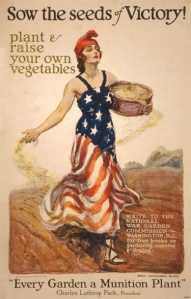A Green Arsenal
September 20, 2013 at 10:00 am smithsoniangardens 3 comments
“Working your own little patch of ground is part of the home front fighter’s front-line assignment. Chief weapon should be tomatoes.”
— From an article in the March 20, 1943 Science News Letter
When the United States joined the Allied forces in World War II, American citizens committed to the war effort. Rationing and other measures impacted ordinary people across the country, especially with regards to metals, munitions, and most importantly, food. To combat food shortages and build national morale, the US government encouraged citizens to cultivate private and community food gardens, called victory gardens. Maintaining a victory garden gave Americans a feeling of patriotic contribution and sense of order and connection to the earth despite the turmoil of war.
In his article, “In the Sweat of Our Brow: Citizenship in American Domestic Practice in WWII – Victory Gardens,” Dr. Char Miller of George Mason University discusses the The US government embarked on a massive propaganda campaign to rouse a passion for food gardens in the American people, through departments like the Office of War Information and the USDA. By growing their own fruits and vegetables, patriotic gardeners reserved more commercially grown food for the troops. Buying fewer commercial goods also reserved other supplies, such as fuel to transport food and metal for cans, for the war effort. Victory gardens yielded better tasting, healthier foods to keep the American people strong despite the stresses of war. War propaganda urged citizens to work hard in their gardens as the labor of gardening also contributed to maintaining a healthy bod, meeting the needs of the nation-state. Victory garden materials, such as magazine articles, posters, and short films, emphasized the importance of planning and efficiency to the effort. Not a single seed, foot of land, or ounce of effort should be wasted. Every citizen needed to be efficient to aid the war effort.
Victory gardens served an important emotional need as well as physical sustenance. As Americans struggled to come to terms with the ravages of modern warfare, especially the atomic bomb, gardening bestowed a sense of calm and order to their lives. Working in the garden reminded people of the rhythms and order of nature, something from which many Americans felt increasing disconnection. In the uncertain times of WWII, citizens needed the assurance that some things in the world still operated under a set of defined rules. Growing their own food also gave Americans a sense of accomplishment, contribution to the war effort, and security in their ability to feed themselves.
Food wasn’t the only thing growing in victory gardens across America. Colorful flowers had their own place in the gardener’s repertoire. The health of the soul mattered almost as much as that of the body, so the government encouraged gardeners to grow flowers to evoke memories and promote tranquility. According to Dr. Miller, seed companies sold British flowers to Americans so those on the home front could experience some of the scents and sights of the troops overseas. Flowers also calmed anxious nerves and produced happier feelings in gardeners. Due to the demands for efficiency, flower gardens contained relatively low maintenance blooms so as not to distract from the overall mission of gardening.
Victory gardens and their accompanying propaganda played an important role in the home front of WWII. The program experienced wild success across the nation, and the concept has lived on into today. You can visit the Smithsonian Gardens’ Victory Garden at the National Museum of American History. Containing heirloom species from the time, the garden grants visitors an authentic feeling of what it may have been like to grow your own food in WWII.
-Amber Schilling, Summer 2013 Education and Outreach Intern
Source: Char Miller, “In the Sweat of Our Brow: Citizenship in American Domestic Practice During WWII – Victory Gardens,” The Journal of American Culture, Vol. 26 Issue 3 (2003): 395-409.
Entry filed under: Garden History. Tags: Victory Garden.
3 Comments Add your own
Leave a reply to Cindy at enclos*ure Cancel reply
Trackback this post | Subscribe to the comments via RSS Feed






1. Cindy at enclos*ure | October 22, 2013 at 11:16 am
Cindy at enclos*ure | October 22, 2013 at 11:16 am
Hi,
Could you explain a little about the interesting looking rolls that border the garden beds in the above pictures? How are they constructed? Thanks!
2. smithsoniangardens | October 23, 2013 at 10:10 am
smithsoniangardens | October 23, 2013 at 10:10 am
Our horticulturalist, Joe Brunetti, told us that the rolls that border the gardens beds are coconut coir which are made from coconut fibers. These fibers are extracted from the husk of a coconut and are typically used in products such as floor mats, doormats, brushes, and mattresses.
3. Cindy at enclos*ure | October 23, 2013 at 1:04 pm
Cindy at enclos*ure | October 23, 2013 at 1:04 pm
Interesting. Thanks! I was thinking they might be a dressed-up version of compost filter socks, which are used to control water run-off.
I am going to post some photos on my blog of the Ripley and Butterfly gardens this week. I was there the last week of September, and they were wonderful. I am a big fan of the S.I. gardens.